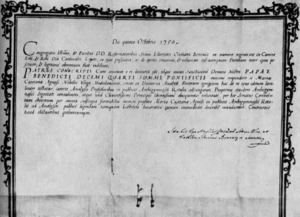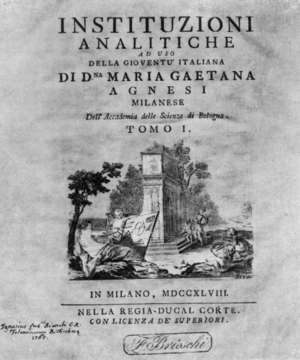Maria Gaetana Agnesi facts for kids
Quick facts for kids
Maria Gaetana Agnesi
|
|
|---|---|
 |
|
| Born | 16 May 1718 |
| Died | 9 January 1799 (aged 80) Milan, Cisalpine Republic
|
| Nationality | Italian |
| Known for | Author of Instituzioni Analitiche ad uso della gioventù italiana (English: Analytical Institutions for the use of Italian youth) |
| Scientific career | |
| Fields | Mathematics |
| Institutions | University of Bologna |
Maria Gaetana Agnesi (born May 16, 1718 – died January 9, 1799) was an amazing Italian woman. She was a mathematician, a philosopher, and a theologian. She also spent much of her life helping others.
Maria Agnesi was the first woman to write a mathematics textbook. She was also the first woman to be named a mathematics professor at a university.
She wrote the first book that talked about both differential and integral calculus. She was part of the faculty at the University of Bologna.
For the last 40 years of her life, Maria focused on studying theology. This is the study of religious beliefs. She also did a lot of charitable work. She helped poor and sick people.
Maria was a very religious Catholic. She believed that studying and thinking about God went well with prayer. Her sister, Maria Teresa Agnesi Pinottini, was a talented musician and composer.
Contents
Early Life and Learning
Maria Gaetana Agnesi was born in Milan, Italy. Her family was very rich and loved learning. Her father, Pietro Agnesi, was a silk merchant. He wanted his family to be part of the Milanese nobility.
Maria was one of 21 children in her family. When her mother died, Maria took over running the household.
A Child Prodigy
Maria was a child prodigy, meaning she was very smart from a young age. By age five, she could speak Italian and French. By age eleven, she knew Greek, Hebrew, Spanish, German, and Latin. People called her the "Seven-Tongued Orator."
When Maria was twelve, she got sick. Doctors thought it was from studying too much. They told her to dance and ride horses. This did not help, and she had strong fits. After this, she was told to study less.
By age fourteen, she was studying ballistics (the science of how things fly) and geometry. When she was fifteen, her father started inviting smart men to their home. Maria would read and discuss difficult philosophical questions with them.
Her father published a book in 1738 called Propositiones Philosophicae. It showed how Maria defended 190 philosophical ideas.
Focus on Mathematics
Maria's father remarried twice. This meant Maria was the oldest of 21 children. She wanted to become a nun, but her father did not agree. Instead, he let her live a quiet life. She could focus on mathematics and do charity work.
Her job was also to teach her many younger brothers and sisters. In 1740, she started studying differential and integral calculus with Ramiro Rampinelli. He was a famous Italian mathematician.
Contributions to Mathematics
Maria Agnesi is known as the first woman in the Western world to become famous in mathematics. Her most important work was a book called Instituzioni analitiche ad uso della gioventù italiana. This means Analytical Institutions for the Use of Italian Youth.
Instituzioni analitiche
This book was published in Milan in 1748. It was seen as the best way to learn about the works of Euler, another famous mathematician. Maria's goal was to explain infinitesimal calculus in a clear way. Calculus is a type of math that helps us understand how things change.
The book combined mathematical analysis with algebra. The first part talked about finite quantities. The second part discussed infinitesimals, which are tiny, tiny amounts.
Her book was translated into French in 1775. An English translation, called Analytical Institutions, came out in 1801. Empress Maria Theresa praised Maria's work. She sent Maria a diamond ring and a special letter. Pope Benedict XIV also sent her a gold wreath and a gold medal.
Maria had help writing her book from two mathematicians. They were her old teacher Ramiro Rampinelli and Jacopo Riccati.
Witch of Agnesi
In her book, Maria Agnesi talked about a special curve. Other mathematicians like Pierre de Fermat and Guido Grandi had studied it before. Grandi called the curve versoria. He also suggested the Italian name versiera.
This name might have been a joke. Versoria is a sailing term. But versiera can also mean "she-devil" or "witch" in Italian. After Maria's book was translated, the curve became known as the "Witch of Agnesi."
Other Writings
Maria Agnesi also wrote about another math book. It was about conic sections by the Marquis Guillaume de l'Hôpital. People who saw her notes praised them, but this work was never published.
Later Life and Charity
In 1750, Maria's father became ill. Pope Benedict XIV then appointed her to be a professor. She was given the chair of mathematics and natural philosophy at Bologna. However, she never actually taught there. She was the second woman ever to be given a professorship at a university. Laura Bassi was the first.
In 1751, Maria became ill again. Her doctors told her not to study. After her father died in 1752, she followed her dream. She started studying theology and helping others.
She gave away the gifts she had received, even begging for money. She used it to help the poor, homeless, and sick. In 1783, she started a home for elderly people in Milan. It was called the Opera Pia Trivulzio. Maria lived there like the nuns who worked there.
Maria Agnesi died on January 9, 1799. She died poor and was buried in a mass grave.
Recognition
Maria Agnesi is still remembered today. In 1996, an asteroid was named 16765 Agnesi after her. There is also a crater on Venus named Agnesi. And, of course, the mathematical curve is called the Witch of Agnesi. She is also featured in a deck of playing cards that show famous women mathematicians.
See also
 In Spanish: María Gaetana Agnesi para niños
In Spanish: María Gaetana Agnesi para niños



